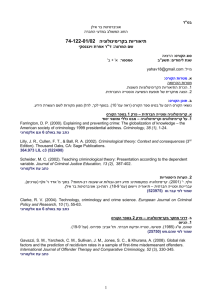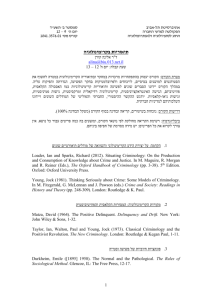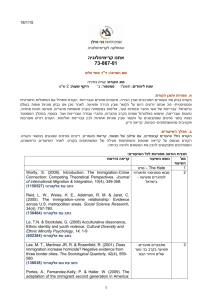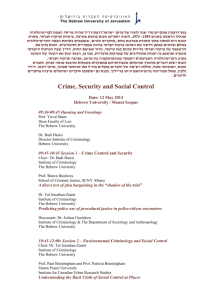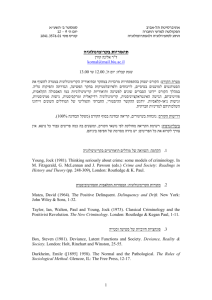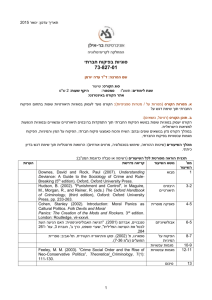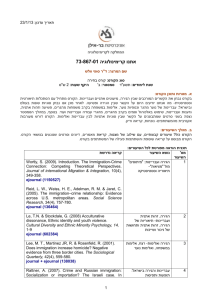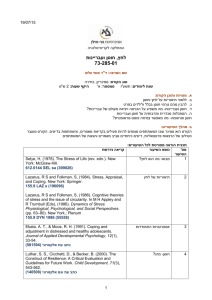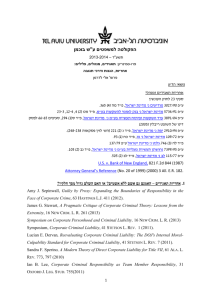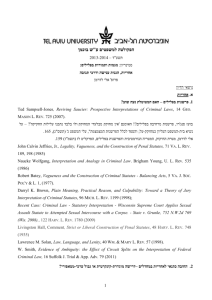תאריך עדכון: 2 ביולי, 2015 המחלקה לקרימינולוגיה תיאוריות וסוגיות נבחרות
advertisement
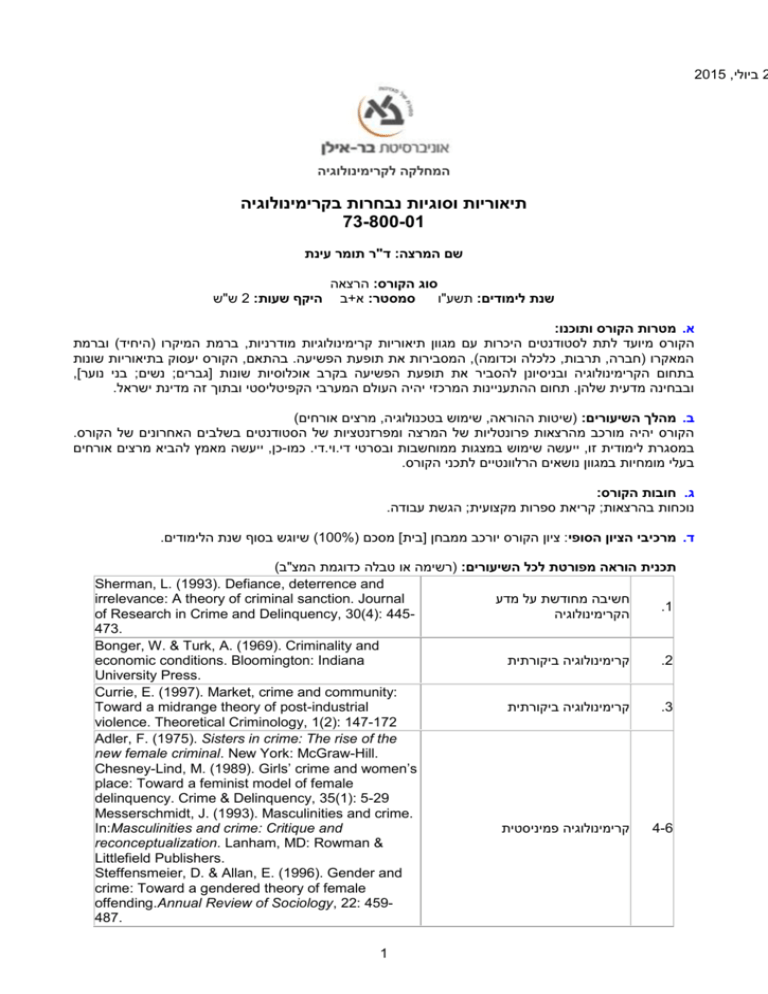
2ביולי2112 , המחלקה לקרימינולוגיה תיאוריות וסוגיות נבחרות בקרימינולוגיה 37-088-80 שם המרצה :ד"ר תומר עינת סוג הקורס :הרצאה סמסטר :א+ב היקף שעות 2 :ש"ש שנת לימודים :תשע"ו א .מטרות הקורס ותוכנו: הקורס מיועד לתת לסטודנטים היכרות עם מגוון תיאוריות קרימינולוגיות מודרניות ,ברמת המיקרו (היחיד) וברמת המאקרו (חברה ,תרבות ,כלכלה וכדומה) ,המסבירות את תופעת הפשיעה .בהתאם ,הקורס יעסוק בתיאוריות שונות בתחום הקרימינולוגיה ובניסיונן להסביר את תופעת הפשיעה בקרב אוכלוסיות שונות [גברים; נשים; בני נוער], ובבחינה מדעית שלהן .תחום ההתעניינות המרכזי יהיה העולם המערבי הקפיטליסטי ובתוך זה מדינת ישראל. ב .מהלך השיעורים( :שיטות ההוראה ,שימוש בטכנולוגיה ,מרצים אורחים) הקורס יהיה מורכב מהרצאות פרונטליות של המרצה ומפרזנטציות של הסטודנטים בשלבים האחרונים של הקורס. במסגרת לימודית זו ,ייעשה שימוש במצגות ממוחשבות ובסרטי די.וי.די .כמו-כן ,ייעשה מאמץ להביא מרצים אורחים בעלי מומחיות במגוון נושאים הרלוונטיים לתכני הקורס. ג .חובות הקורס: נוכחות בהרצאות; קריאת ספרות מקצועית; הגשת עבודה. ד .מרכיבי הציון הסופי :ציון הקורס יורכב ממבחן [בית] מסכם ( )111%שיוגש בסוף שנת הלימודים. תכנית הוראה מפורטת לכל השיעורים( :רשימה או טבלה כדוגמת המצ"ב) Sherman, L. (1993). Defiance, deterrence and irrelevance: A theory of criminal sanction. Journal חשיבה מחודשת על מדע .1 of Research in Crime and Delinquency, 30(4): 445הקרימינולוגיה 473. Bonger, W. & Turk, A. (1969). Criminality and economic conditions. Bloomington: Indiana קרימינולוגיה ביקורתית .2 University Press. Currie, E. (1997). Market, crime and community: Toward a midrange theory of post-industrial קרימינולוגיה ביקורתית .3 violence. Theoretical Criminology, 1(2): 147-172 Adler, F. (1975). Sisters in crime: The rise of the new female criminal. New York: McGraw-Hill. Chesney-Lind, M. (1989). Girls’ crime and women’s place: Toward a feminist model of female delinquency. Crime & Delinquency, 35(1): 5-29 Messerschmidt, J. (1993). Masculinities and crime. In:Masculinities and crime: Critique and קרימינולוגיה פמיניסטית 4-6 & reconceptualization. Lanham, MD: Rowman Littlefield Publishers. Steffensmeier, D. & Allan, E. (1996). Gender and crime: Toward a gendered theory of female offending.Annual Review of Sociology, 22: 459487. 1 Stafford, M. & Warr, M. (1993). A reconceptualization of general and specific תיאוריות ההרתעה והבחירה החופשית deterrence. Journal of Research in Crime and Delinquency, 30(2): 123-135. Cornish, D. & Clarke, R. (1986). Crime as a rational choice. In: The Reasoning Criminal. New York: תיאוריות ההרתעה והבחירה החופשית Springer-Verlag. Cornish, D. & Clarke, R. (1986). Crime as a rational choice. In: The Reasoning Criminal. New York: תיאוריות ההרתעה והבחירה החופשית Springer-Verlag. Cohen, L. & Felson, M. (1979). Social change and crime rate trends: A routine activity קרימינולוגיה סביבתית approach. American Sociological Review, 44: 588608. Clarke, R. (1980). Situational crime prevention: Theory and practice. British Journal of Criminology, קרימינולוגיה סביבתית 20: 136-147. Wilson, J. & Kelling, G. (1982). Broken קרימינולוגיה סביבתית windows. The Atlantic Monthly, 249(3): 29-38. Moffitt, T. (1993). Adolescence-limited and lifecourse-persistent antisocial behaviour: A תיאוריות התפתחותיות developmental taxonomy. Psychological Review, 100(4): 674-701. Moffitt, T. (1993). Adolescence-limited and lifecourse-persistent antisocial behaviour: A תיאוריות התפתחותיות developmental taxonomy. Psychological Review, 100(4): 674-701. Laub, J. & Sampson, R. (2003).Shared beginnings, divergent lives: Delinquent boys at age 70. תיאוריות התפתחותיות Cambridge, MA: Harvard University Press. Laub, J. & Sampson, R. (2003).Shared beginnings, divergent lives: Delinquent boys at age 70. תיאוריות התפתחותיות Cambridge, MA: Harvard University Press. Sutherland, E. (1940). White-collar "עבריינות "צווארון לבן criminality. American Sociological Review, 5: 1-12. Benson, M. (1985). Denying the guilty mind: Accounting for involvement in white-collar "עבריינות "צווארון לבן crime. Criminology, 23: 583-607. Shover, N. & Hochstetler, A. (2006).Choosing white-collar crime. New York: Cambridge University "עבריינות "צווארון לבן Press. Shover, N. & Hochstetler, A. (2006).Choosing white-collar crime. New York: Cambridge University "עבריינות "צווארון לבן Press. Thornberry, T. (1987). Toward an interactional תיאוריות משולבות בקרימינולוגיה theory of delinquency.Criminology, 25: 863-891. Tittle, C. (2001). Control balance. In: R. Paternoster. And R. Bachman (eds.), Explaining תיאוריות משולבות בקרימינולוגיה criminals and crime (pp. 315-334). Los Angeles: Roxbury. Cullen, F. (1994). Social support as an organizing concept for criminology: Presidential address to the תיאוריות משולבות בקרימינולוגיה Academy of Criminal Justice Sciences. Justice quarterly, 11(4): 527-559. Agnew. R. (2005). Why do criminals offend? A תיאוריות משולבות בקרימינולוגיה 2 .7 .8 .9 .11 .11 .12 .13 .14 .12 .16 .17 .18 .19 .21 .21 .22 .23 .24 general theory of crime and delinquency. Oxford: Oxford University Press. Agnew. R. (2005). Why do criminals offend? A general theory of crime and delinquency. Oxford: Oxford University Press. תיאוריות משולבות בקרימינולוגיה .22 שיעור חזרה מסכם 26 : ביבליוגרפיה.ה : ספרי עזר נוספים ומאמרים,)textbook( ספר לימוד Cullen, F., Agnew, R & Wilcox, P. (2013). Criminological Theory: Past to present (5th edition). Oxford: Oxford University Press. 364 CRI 2014 (3703333) Sherman, L. (1993). Defiance, deterrence and irrelevance: A theory of criminal sanction. Journal of Research in Crime and Delinquency, 30(4), 442-473 . )001018( כתב עת אלקטרוני Turk, A. (1969). Criminality and economic conditions. Bloomington: Indiana University 364 BON ca (308001) Currie, E. (1997). Market, crime and community: Toward a midrange theory of post-industrial violence .Theoretical Criminology 1(2): 147-172. )735600( כתב עת וגם אלקטרוני Adler, F. (1975). Sisters in crime: The rise of the new female criminal .New York: McGraw-Hill. 364.374 ADL s (016387) Chesney-Lind, M. (1989). Girls’ crime and women’s place: Toward a feminist model of female delinquency .Crime & Delinquency 35(1) :2-29 )013067( כתב עת אלקטרוני Messerschmidt, J. (1993). Masculinities and crime. In: Masculinities and crime: Critique and reconceptualization .Lanham, MD: Rowman & Littlefield Publishers. אין Steffensmeier, D & Allan, E. (1996). Gender and crime: Toward a gendered theory of female offending .Annual Review of Sociology, 22: 429-487 )078885( כתב עת וגם אלקטרוני Stafford, M & Warr, M. (1993). A reconceptualization of general and specific deterrence. Journal of Research in Crime and Delinquency, 30(2): 123-132 )001577( כתב עת אלקטרוני Cornish, D & Clarke, R. (1986). Crime as a rational choice. In: The Reasoning Criminal. New York: Springer-Verlag 364.3 REA 1986 (63760) Cohen, L & Felson, M. (1979). Social change and crime rate trends: A routine activity approach .American Sociological Review, 44: 288-618 . )001577( כתב עת וגם אלקטרוני Clarke, R. (1980). Situational crime prevention: Theory and practice .British Journal of Criminology, 20: 136-147 )073376( כתב עת אלקטרוני Wilson, J & .Kelling, G. (1982). Broken windows .The Atlantic Monthly, 249(3):29-38 )150011( כתב עת אלקטרוני 3 Moffitt, T. (1993). Adolescence-limited and life-course-persistent antisocial behaviour: A developmental taxonomy.Psychological Review, 100(4): 674-701. )073013( כתב עת בספרייה לפסיכולוגיה וגם אלקטרוני Laub, J & .Sampson, R. (2003). Shared beginnings, divergent lives: Delinquent boys at age 70 . Cambridge, MA: Harvard University Press. )3710060( ספר אלקטרוני Sutherland, E. (1940). White-collar criminality. American Sociological Review, 5:1-12 )001577( כתב עת וגם אלקטרוני Benson, M. (1985). Denying the guilty mind: Accounting for involvement in white-collar crime .Criminology, 23: 283-617 )065858( כתב עת אלקטרוני Shover, N. & Hochsteller, A. (2006). Choosing White-Collar crime. New York, Cambridge University Press. 364.168 SHO c (0080360) Thornberry, T. (1987). Toward an interactional theory of delinquency. Criminology, 25: 863-891 )065858( כתב עת אלקטרוני Tittle, C. (2001). Control balance. In: R. Paternoster. and R. Bachman (eds)., Explaining criminals and crime )pp. 315-334). Los Angeles: Roxbury. אין Cullen, F. (1994). Social support as an organizing concept for criminology: Presidential address to the Academy of Criminal Justice Sciences .Justice quarterly, 11(4): 227-229 )001053( כתב עת וגם אלקטרוני Agnew, R. (2005) Why do criminals offend? A general theory of crime and delinquency. Oxford: Oxford University Press. אין 4
